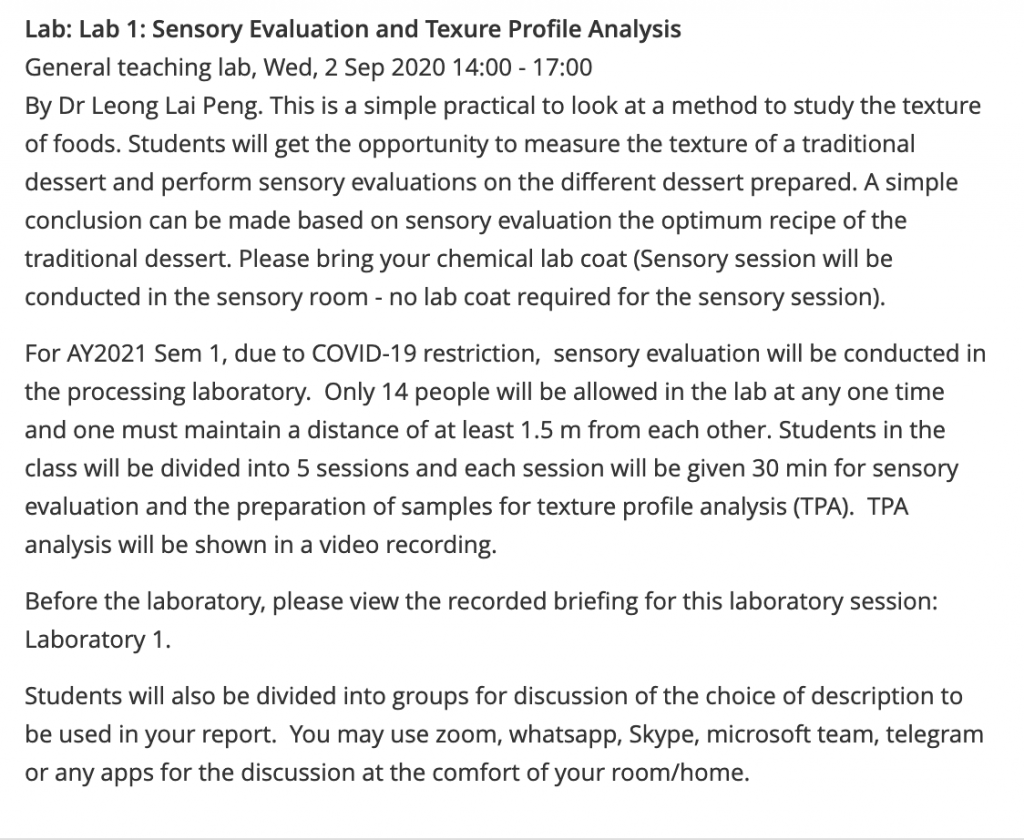LEONG Lai Peng
Department of Food Science and Technology, Faculty of Science (FOS)
This blog post is contributed by Lai Peng, one of the panelists of the session on “Educators’ Challenges and Successes” at the e-learning Symposium 2020, held on 8 June 2020. In this post, she shares ideas on the use of LumiNUS.

The sudden wave of COVID-19 infections left all of us in educational institutions scrambling to find solutions for an enriched online teaching and learning experience. At the National University of Singapore (NUS), some of us have been using the institution’s content management system, LumiNUS, to organise our module content and its delivery. This experience has also opened up a lot of teaching and learning opportunities, and perhaps motivated us to do more with LumiNUS.
This post summarises and shares some of the tools that may be useful to colleagues keen to explore LumiNUS beyond its basic features.
Learning Flow
When the semester re-opens in August 2020, the first thing students are interested in will be what is planned for each of their modules. Since we will not be meeting them face-to-face, the Learning Flow on LumiNUS will give them a good idea of what is in store for them in a particular module (see Table 1). Beyond this, pre-recorded videos can be embedded into the Learning Flow, uploaded onto the appropriate folders, and published on a weekly basis, which is similar to normal classes.
Items on the Learning Flow
![]()
Web or recorded lectures can be embedded into the learning plan.

![]()
Details of reading materials can also be added. It will be helpful to use an e-book.

![]()
Lecture materials for students to print out.

![]()
Zoom links can also be embedded

![]()
Example of instructions for a laboratory session where part of the lab will be done via e-learning.

Forum
To encourage discussion, the Forum can be used (see Figure 1). It can be organised based on instructional weeks or topics. Normally within a module, a certain percentage of continuous assessment can be allocated to evaluating level of participation in the Forum to encourage students to contribute. In the event that the Forum is very active, participation can be rewarded based on participation tiers, for example, the top 10% will be rewarded maximum marks, followed by next tier and so on. Participation tiers can be based on frequency of participation, type of and quality of posts. However, do note that moderating a forum can be tedious and one may require help from teaching assistants.
Figure 1. Discussion Forum on LumiNUS
Quiz
Whether it is a pre-recorded or “live” Zoom lecture, one can engage students by using LumiNUS Quiz at various intervals. Some of these quizzes can contribute to the overall marks for continuous assessment. One can also opt to conduct e-examinations via LumiNUS. To evaluate lower-level thinking skills, one can set multiple choice, and fill-in-the-blanks questions. It is also important to set restrictions to the answers (for example, 1-word, rounding numeric responses to two significant figures, no abbreviations etc.) for auto-marking or short answer questions.
In addition, the number of questions set must be more than enough to occupy the entire duration of the examination and should be presented randomly. This makes it harder for students to discuss the questions with one another as what they each receive will likely be different from each other at any point of time. Although students can still search for answers on the internet or in e-books, the time spent searching for the answer means they answer fewer questions, which might cost them marks. Thus, students who are better prepared and with answers at their fingertips are expected to perform better.
In order to elicit higher-level thinking skills, one can consider higher-order essay questions with students submitting their answers as PDF files to LumiNUS with plagiarism checks activated. While students can discuss, the time taken for discussion will take away time needed to address the question. They will also have to answer the questions using their own words, or the plagiarism check will detect high similarities in their submissions, leading to risk of plagiarism and suffering the corresponding penalties.
I hope this post has contributed ideas on how we could optimise LumiNUS to organise e-learning materials in the coming semester.
 |
LEONG Lai Peng is a senior lecturer in the Department of Food Science and Technology. Lai Peng has used and abused the institution’s previous content management system, the IVLE, since its creation until its ultimate destruction. She has since moved on to discover the good, the bad and the ugly of LumiNUS. During her free time, she enjoys creating disruptive new food products. Lai Peng can be reached at laipeng@nus.edu.sg. |

